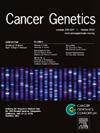77. dic(7;9):A distinct entity in B-ALL with multiple genomic aberrations including IKAROS and PAX5
IF 1.4
4区 医学
Q4 GENETICS & HEREDITY
引用次数: 0
Abstract
dic(7;9) is a rare (<1%) and recurrent abnormality in both pediatric and adult B-ALL, resulting in partial monosomy of chromosomes 7p and 9p. Co-occurrence of dic(7;9) with PAX5 gene alterations including deletions, mutations and amplification have been reported. PAX5 encodes the B lymphoid transcription factor gene that is important in regulating B cell lineage differentiation, leading to B-cell development and may play a crucial role in B lymphoid leukemogenesis.
Here, we present two cases of pediatric B-ALL with dic(7;9) with complex genomic aberrations.
Case 1: is a four year old female who presented in 2024 with orbital and left sinus maxillary masses, anemia, fever and leukocytosis with peripheral blasts. Karyotype and fish were complex with 45,XX,der(7)dic(7;9)(p11.2;p13)del(7)(p13p11.2)t(7;20)(p13;q11.2),der(20)t(7;20)(p13;q11.2)[13]/46,XX[7]. SNP array revealed loss of 7p and 9p including IKAROS and PAX5, respectively.
Cerebral sinus fluid demonstrated a leukocytosis with leukemic blasts, resulting in a CNS3b classification. She had negative minimal residual disease at the end of induction on a very high-risk standard of care protocol and on consolidation therapy.
Case 2: is a 10 year old male referred in 2022 for a month of fever and fatigue.. karyotype was complex with several rearrangements. 45,XY,dic(7)t(7;9)(p13;p13),-9,der(10)t(9;10)(q34.1;q22),der(12)t(7;12)(p13;p13),der(13)t(10;13)(q22;q34)[11]/46,XY[9].
The patient was treated on a standard risk standard of care protocol and had negative minimal residual disease at the end of induction. He remains in remission during maintenance therapy.
Given the two dic (7;9) cases described here have complex karyotypes, it is possible that PAX5 and IKZF1 alterations may be contributing to this complex cytogenetic entity.
DIC(7;9):B-ALL 中的一个独特实体,具有多种基因组畸变,包括 IKAROS 和 PAX5
dic(7;9)是小儿和成人 B-ALL 中的一种罕见(<1%)和复发性异常,导致 7p 和 9p 染色体部分单体。有报道称,dic(7;9)与PAX5基因改变(包括缺失、突变和扩增)同时存在。PAX5编码B淋巴转录因子基因,在调控B细胞系分化、导致B细胞发育方面具有重要作用,并可能在B淋巴白血病发生中发挥关键作用。在此,我们介绍了两例伴有复杂基因组畸变的dic(7;9)的小儿B-ALL病例。病例1:是一名四岁女性,于2024年出现眼眶和左上颌窦肿块、贫血、发热和白细胞增多伴外周血块。核型和鱼形图为 45,XX,der(7)dic(7;9)(p11.2;p13)del(7)(p13p11.2)t(7;20)(p13;q11.2),der(20)t(7;20)(p13;q11.2)[13]/46,XX[7] 的复杂组合。SNP阵列显示7p和9p分别缺失,其中包括IKAROS和PAX5。脑窦液显示白细胞增多,并伴有白血病血泡,结果被分为CNS3b。病例 2:男性,10 岁,因发热和乏力一个月于 2022 年转诊,核型复杂,有多个重排。45,XY,dic(7)t(7;9)(p13;p13),-9,der(10)t(9;10)(q34.1;q22),der(12)t(7;12)(p13;p13),der(13)t(10;13)(q22;q34)[11]/46,XY[9]。鉴于本文描述的两例双(7;9)染色体病例具有复杂的核型,PAX5和IKZF1的改变可能是导致这种复杂细胞遗传实体的原因。
本文章由计算机程序翻译,如有差异,请以英文原文为准。
求助全文
约1分钟内获得全文
求助全文
来源期刊

Cancer Genetics
ONCOLOGY-GENETICS & HEREDITY
CiteScore
3.20
自引率
5.30%
发文量
167
审稿时长
27 days
期刊介绍:
The aim of Cancer Genetics is to publish high quality scientific papers on the cellular, genetic and molecular aspects of cancer, including cancer predisposition and clinical diagnostic applications. Specific areas of interest include descriptions of new chromosomal, molecular or epigenetic alterations in benign and malignant diseases; novel laboratory approaches for identification and characterization of chromosomal rearrangements or genomic alterations in cancer cells; correlation of genetic changes with pathology and clinical presentation; and the molecular genetics of cancer predisposition. To reach a basic science and clinical multidisciplinary audience, we welcome original full-length articles, reviews, meeting summaries, brief reports, and letters to the editor.
 求助内容:
求助内容: 应助结果提醒方式:
应助结果提醒方式:


